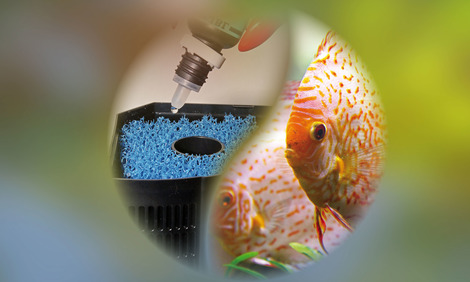Most people are a little shocked when they hear about bacteria. The bacteria in JBL Denitrol and JBL StartKit are not harmful to humans and dosing cannot harm you. The bacteria in these products will not enter the atmosphere because nitrifying bacteria are by nature bound to substrates in watery or at least moist environments.
In the previous post about bacteria starters Bacteria starter – starting an aquarium without a run-in phase – Part 1 we discussed the use and necessity of bacterial products in aquariums. In this one we will answer your frequently asked questions on the subject.
What activates the bacteria?
The bacteria rest on a “minimum demand” nutrient solution inside the bottle, because a full-scale enactment of their metabolism would shorten the product’s shelf life. The shelf life is 18 months, as long as the bottle is in its original packaging and stored at temperatures between 4-35 °C. The respective date is printed on each bottle.
How can you tell if the bacteria solution is active? If the liquid is clear or has occasional small brownish flocks, the product is fine. The smell should be scarcely discernible. If the liquid smells of rotten eggs or if it contains black flakes, the product is no longer suitable for use.
What needs to be kept in mind?
We have already explained that bacteria need food. Without food they die off and will never achieve their desired result. Furthermore any UV-C water clarifiers need to stay switched off. The bacteria need some time to collect on the substrate and float around in the water until they do. The UV-C radiation would kill off the “stray” bacteria before they have the chance to settle. We therefore recommend you keep the UV-C clarifier switched off for 48 hours before dosing.
During this time please feed your fish very sparingly with a maximum of 25% of the usual amount. The bacteria are adapting to the current water load and are easily overstrained. A slow increase allows the bacteria to adapt firmly to their environment.
When the nitrite content is already high
To answer this question in detail you need to know the current nitrite value and how it has developed in about four hours since the last feed. High nitrite values can lead to the inhibition of the bacterial nitrite breakdown. Too much nitrite hinders the bacteria in their development and work.
What needs to be done to make the bacteria work again in this case?
- Carry out a big water change, depending on the nitrite level. If the level is more than 1.0 mg/l, change at least 50% of the water to reduce the current nitrite value. Add a high dosage of JBL Denitrol to the aquarium (approx. 250 ml per 150 l aquarium water). Actively aerate the aquarium with a diaphragm pump or adjust the filter outlet so that a corresponding amount of air enters through the water surface. The whitish clouding, caused by bacteria, disappears within a few hours and then the bacteria immediately start to break down ammonium/ammonia and nitrite.
Do you have any further questions about the use of bacteria products in your aquarium? Write a comment below and look in a little later for the answer to your question.
